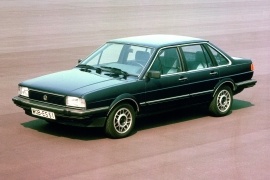VOLKSWAGEN Santana Models/Series Timeline, Specifications & Photos
First production year: 1982
Engines: Gasoline, Diesel
In 1982, Volkswagen introduced the Santana model for specific markets, but it was more of a badge-engineered Passat B2, with small differences.
The German carmaker saw the opportunity to use specific names for specific markets. In Spanish and Portuguese-speaking countries, the name was easier to remember than the Passat. That's why in South America, Volkswagen kept the nameplate for longer times. It was also used for vehicles built in 1983 at the SAIC (Shanghai Tractor Automobile Corporation) in China.
Its angular lines, the big rectangular headlights, and the plastic bumper were a fresh look on the market. The three-box sedan version was not the most popular on the market, but it was considered an excellent middle-management vehicle thanks to its roomy interior. Soon, it became popular for families as well.
Inside, Volkswagen installed two large dials on the dashboard for the speedometer and tachometer in the angular instrument cluster and two smaller gauges for fuel and coolant temperatures. There was an area with ten lights for turn signals, hazard, oil pressure, parking brakes, and a few other warning lights in the middle.
Volkswagen offered the Passat a wide choice of engines, both diesel and gasoline. Its long-range autonomy, of over 1000 km (623 miles), made it one of the most cost-effective cars on the market. Its reliability and low running costs increased over the years.
